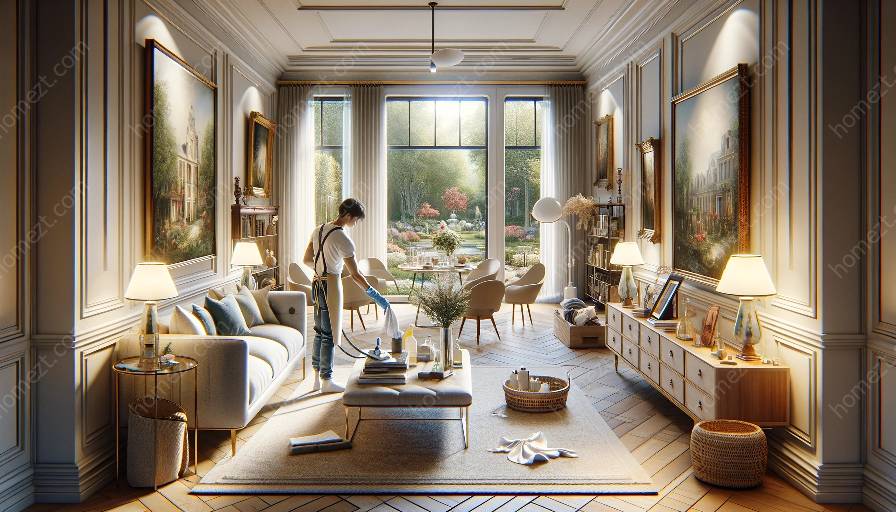Art and collectibles require careful maintenance to ensure their longevity and preserve their value. Preventive conservation techniques help safeguard these precious items from deterioration and damage, ensuring they can be enjoyed for generations to come. In this comprehensive guide, we'll explore various preventive conservation techniques for art and collectibles, as well as their compatibility with cleaning techniques and home cleansing methods.
Understanding Preventive Conservation
Preventive conservation involves the proactive measures taken to minimize the risks and potential causes of deterioration and damage to art and collectible items. This approach aims to create a stable environment for the preservation of these objects, reducing the need for extensive restoration and ensuring their longevity.
Environmental Control
One of the fundamental elements of preventive conservation is environmental control. Maintaining stable environmental conditions, including temperature, humidity, and light levels, is crucial for preserving art and collectibles. Proper storage and display environments can significantly reduce the risk of deterioration and damage.
Temperature and Humidity Control
Fluctuations in temperature and humidity can have detrimental effects on art and collectibles, leading to warping, cracking, mold growth, and other forms of deterioration. Implementing climate control systems and using appropriate storage solutions can help regulate these environmental factors and protect valuable items.
Lighting Management
Exposure to light, especially ultraviolet (UV) radiation, can cause fading, discoloration, and other forms of damage to artworks and collectibles. Using UV-filtering glass, implementing limited lighting exposure, and rotating displayed items can help mitigate the harmful effects of light.
Proper Handling and Storage
Effective preventive conservation also involves proper handling and storage practices. Using high-quality archival materials such as acid-free paper, inert plastics, and stable storage containers can help protect art and collectibles from physical and chemical deterioration.
Handling Guidelines
When handling art and collectibles, it is essential to use clean, dry hands or wear protective gloves to prevent the transfer of oils, dirt, and other contaminants. Additionally, implementing gentle handling techniques and avoiding excessive touching can minimize the risk of damage.
Storage Solutions
Choosing suitable storage solutions, such as acid-free boxes, padded mounts, and climate-controlled cabinets, is crucial for preserving art and collectibles. Proper support and protection can prevent structural damage and deterioration over time.
Integrated Pest Management
Protecting art and collectibles from pests and microorganisms is a key aspect of preventive conservation. Integrated pest management strategies, including regular monitoring, preventive measures, and targeted treatments, can help safeguard valuable items from infestations and related damage.
Compatibility with Cleaning Techniques
Preventive conservation techniques for art and collectibles are closely linked to cleaning methods, as maintaining a clean environment is vital for preservation. While preventive conservation focuses on proactive measures, cleaning techniques help remove contaminants and impurities that can contribute to deterioration.
Gentle Cleaning Practices
When cleaning art and collectibles, it is essential to use gentle, non-invasive methods to avoid causing damage. Dry brushing, gentle vacuuming with specialized attachments, and mild solvent-based cleaning solutions can effectively remove surface dust and dirt without harming the items.
Compatibility with Home Cleansing Techniques
Home cleansing techniques can complement preventive conservation and cleaning methods by promoting a clean and stable environment for art and collectibles. Simple practices such as regular dusting, maintaining consistent humidity levels, and avoiding direct sunlight exposure can contribute to the preservation of valuable items within a home environment.
The Importance of Preventive Conservation
By implementing preventive conservation techniques, art and collectible enthusiasts can protect their valuable possessions from the effects of environmental factors, physical handling, and pest infestations. These proactive measures, in conjunction with compatible cleaning and home cleansing techniques, play a crucial role in safeguarding the integrity and longevity of cherished items. Whether protecting delicate artworks, rare collectibles, or precious heirlooms, the application of preventive conservation techniques is essential for preserving the cultural and historical significance of these objects.


